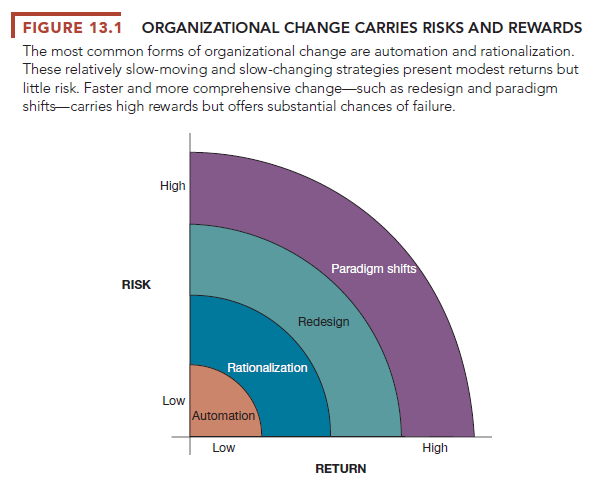Information technology can promote various degrees of organizational change, ranging from incremental to far-reaching. Figure 13.1 shows four kinds of structural organizational change that are enabled by information technology: (1) automation, (2) rationalization, (3) business process redesign, and (4) paradigm shifts. Each carries different risks and rewards.
The most common form of IT-enabled organizational change is automation. The first applications of information technology involved assisting employees with performing their tasks more efficiently and effectively. Calculating paychecks and payroll registers, giving bank tellers instant access to customer deposit records, and developing a nationwide reservation network for airline ticket agents are all examples of early automation.
A deeper form of organizational change-one that follows quickly from early automation—is rationalization of procedures. Automation frequently reveals new bottlenecks in production and makes the existing arrangement of procedures and structures painfully cumbersome. Rationalization of procedures is the streamlining of standard operating procedures. For example, Cameron International’s new system for financial reporting is effective not only because it uses computer technology but also because the company simplified its business processes for this function. Fewer manual steps are required.

Rationalization of procedures is often found in programs for making a series of continuous quality improvements in products, services, and operations, such as total quality management (TQM) and Six Sigma. Total quality management (TQM) makes achieving quality an end in itself and the responsibility of all people and functions within an organization. TQM derives from concepts developed by American quality experts such as W. Edwards Deming and Joseph Juran, but it was popularized by Japanese organizations. Six Sigma is a specific measure of quality, representing 3.4 defects per million opportunities. Most companies cannot achieve this level of quality but use six sigma as a goal for driving ongoing quality improvement programs.
A more powerful type of organizational change is business process redesign, in which business processes are analyzed, simplified, and redesigned. Business process redesign reorganizes workflows, combining steps to cut waste and eliminate repetitive, paper-intensive tasks. (Sometimes the new design eliminates jobs as well.) It is much more ambitious than rationalization of procedures, requiring a new vision of how the process is to be organized. The Interactive Session on Organizations presents another example.
Rationalizing procedures and redesigning business processes are limited to specific parts of a business. New information systems can ultimately affect the design of the entire organization by transforming how the organization carries out its business or even the nature of the business. For instance, the long-haul trucking and transportation firm Schneider National used new information systems to change its business model. Schneider created a new business managing
logistics for other companies. This more radical form of business change is called a paradigm shift. A paradigm shift involves rethinking the nature of the business and the nature of the organization.
Paradigm shifts and business process redesign often fail because extensive organizational change is so difficult to orchestrate (see Chapter 14). Why, then, do so many corporations contemplate such radical change? Because the rewards are equally high (see Figure 13.1). In many instances, firms seeking paradigm shifts and pursuing reengineering strategies achieve stunning, order-of-magni- tude increases in their returns on investment (or productivity). Some of these success stories, and some failure stories, are included throughout this book.
Source: Laudon Kenneth C., Laudon Jane Price (2020), Management Information Systems: Managing the Digital Firm, Pearson; 16th edition.

We stumbled over here from a different web address and thought I should check things out. I like what I see so now i am following you. Look forward to checking out your web page repeatedly.